Porto-North-Portugal.com
The best independent guide to Porto
Porto-North-Portugal.com
The best independent guide to Porto
Porto to Coimbra by train and bus in 2025
Porto and Coimbra are both fascinating tourist destinations in Portugal. Coimbra is a characterful university city, while vibrant Porto is steeped in history.
Coimbra is 120km south of Porto, and there is excellent public transport linking the two cities. This makes it possible to visit Coimbra as a day trip from Porto.
Both cities lie along the primary north-south railway and expressway (the A1) and are connected by fast train and intercity bus services. The best method of travel is by the Alfa Pendular express train (taking just 1 hour and 9 minutes and costing €18.70), but intercity bus travel is significantly cheaper, with fares as low as €4.99.
This article will detail how to travel from Porto to Coimbra by public transport, along with station information and how to travel from the airport.
Related articles: Porto Guide - Coimbra guide
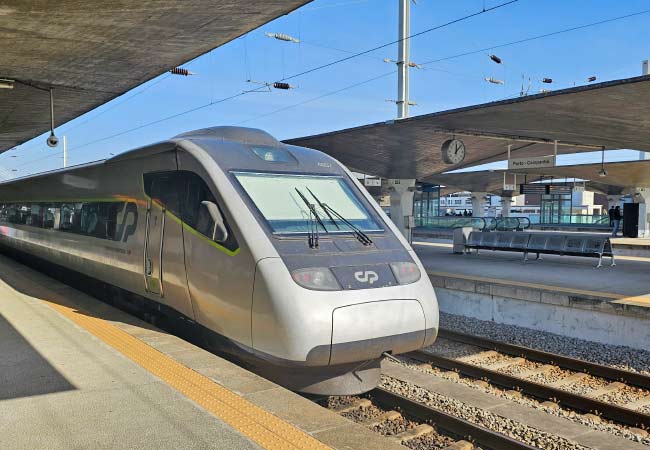
The Alfa Pendular train from Porto to Coimbra is modern, fast and comfortable.
Travel from Porto to Coimbra
There are many options for travelling between Porto and Coimbra, including:
Driving along the A1 expressway - Porto and Coimbra are connected by the A1 Expressway, and the journey takes approximately 1 hour and 10 minutes by car (plus any traffic time within the cities). The A1 is a toll expressway, with a surprisingly high toll of €7.10.
Warning: If travelling by car, please be aware of tolls and how to pay them. Details are provided at the end of this guide. Brisa, the company that manages the roads, has recently discovered that foreign tourists are a great source of funds and is quick to issue fines.
Comboios de Portugal (CP) - Train travel between Coimbra and Porto is fast and comfortable; however, the downside is that it costs much more than the bus. There are three types of train: the fast and modern Alfa Pendular (AP), slightly cheaper Intercidades (IC intercity), and the excruciatingly slow regional (R) trains. The Alfa Pendular takes just 1 hour and 9 minutes, with a single fare costing €18.70, whereas the IC takes 1 hour 17 minutes and costs €14.60 (full details later in the guide). Train travel between Porto and Coimbra is very luxurious, especially in first class, making it a great choice if you’re a higher-end traveller.
Trains depart from Porto's Campanhã train station, and in Coimbra, all trains stop at the ‘Coimbra B’ station. These stations are not close to the historic centres of either city, and an additional train, taxi or Uber ride is required. For the latest timetables and ticket booking, please see the Comboios de Portugal website: www.cp.pt/
FlixBus - A low-cost bus operator that provides the cheapest fares between Porto and Coimbra. The direct service takes only 1 hour and 20 minutes, and fares can be as low as €4.99 if booked far enough in advance.
In Porto, FlixBus leaves from the Campanhã bus station, but inconveniently terminates on the Rua do Padrão in Coimbra, which is near Coimbra B train station. This means you will need to take a taxi or Uber to get to the centre.
The downside to the FlixBus low-cost business model is that buses need to be nearly full, and they will often have at least 80 per cent of the seats sold. For bookings, see their website FlixBus
Rede Expressos - This is the main intercity bus company of Portugal, which provides direct bus services from Porto to Coimbra. Their fares are typically more expensive than those of FlixBus, but are still much cheaper than train travel.
The advantage of Rede Expressos for the Porto to Coimbra route is that the buses terminate at the main bus station of Coimbra, and from here it is within walking distance to the historic centre. rede-expressos.pt/
Private transfer - The fastest and most convenient way to travel between Porto and Coimbra, however it is also the most expensive. This may be a good option if you are travelling as a group of four.
Advice: While many third-party websites sell train and bus tickets, it is advisable to book directly with the transport companies. Buying directly will reduce booking fees and ensure each company is more accommodating if there are issues.
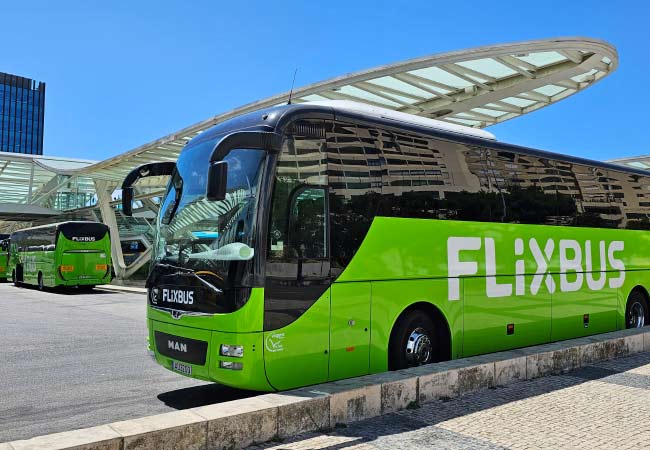
How best to travel from Porto to Coimbra?
The standard of both bus and train travel between the two cities is very high, and there is not much to separate them.
The real decision is whether you prefer comfort over cost. Train travel is marginally faster, the seats are larger, and the carriages are more spacious than a bus.
Intercity bus travel has significantly reduced in price over the last five years and now is much cheaper than the train. The bus is a great option for a day trip to Coimbra, with a return journey in the peak season typically costing less than €15 (while the train will be around €34, depending on the service).
Book your seats in advance!
If there's one key takeaway from this article, it should be to book your tickets (for both bus and train) well in advance of your journey. Booking in advance will not only save you money but also secure your seats, as popular services often sell out during peak season.
Express train services between Porto and Coimbra have a limited number of seats, and once sold out, no more tickets will be available. There is no standing allowed on the Alfa Pendular or Intercidades trains.
Buses between Porto and Coimbra can get extremely busy during popular times, such as Friday evenings and weekends.
Both FlixBus and Rede Expressos use dynamic pricing, where seat prices start low and then increase with demand. FlixBus is generally cheaper than Rede Expressos; however, it is always worth checking both websites.
The following sections will detail bus and train travel in depth.
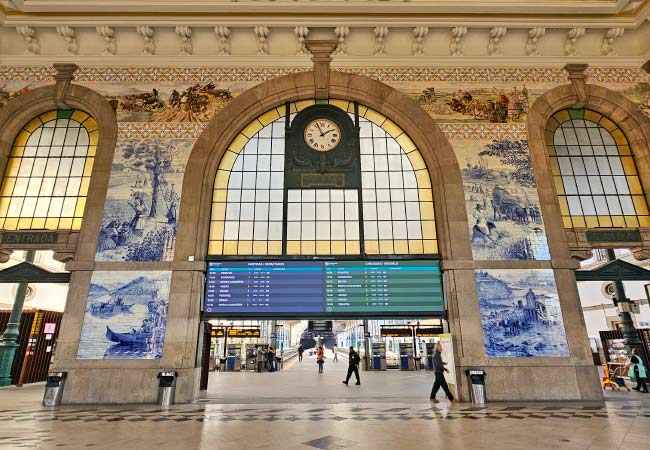
São Bento train station is decorated with beautiful tile paintings.
Porto to Coimbra by train
The express train from Porto to Coimbra is the recommended means of travel. There are two classes of express train, the Intercidades (IC) and the Alfa Pendular (AP). The Alfa Pendular are the more modern trains, with a higher level of comfort and fewer stops, but these are slightly more expensive.
Insight: There are regional train services between Porto and Coimbra, but they are incredibly slow (taking over 2 hours) and should be avoided. The regional train fares are cheaper (€ 9.40) than the express IC or AP services, but if you are looking to save money, take the bus.
The Alfa Pendular journey from Porto to Coimbra takes 1 hour and 9 minutes, while the Intercidades takes 1 hour and 17 minutes. The cost of a single adult fare on the Alfa Pendular from Porto to Coimbra is €24.50/€18.70 (first/standard), whereas the Intercidades is €19/€14.60 (first/standard).
There are over 20 daily services, with more from Monday to Friday. The entire timetable can be seen on the Comboios de Portugal (CP) website:
www.cp.pt/
This link is a PDF, and it may download on certain mobile phones.
Insight: Instead of looking at confusing timetables, it is often easier to use the search feature on the Comboios de Portugal website. www.cp.pt/
Tickets for all express trains need to be purchased before travel, and there is a limited number of seats. Each ticket is assigned a seat, so popular train services do sell out - never just turn up at the train station and expect to get a seat!
There are reductions for children (50 per cent discount), under 25s (25 per cent discount), seniors 65+ (50 per cent discount) or when buying a return ticket (10 per cent reduction). These age-related discounts can be applied when purchasing online during the ‘options’ stage of the booking process. If using any age-based discounts, always travel with a valid ID to prove your age.
Insight: There are many third-party train and bus booking websites that make their money from booking fees. These types of websites will never be cheaper than purchasing directly from the train or bus company.
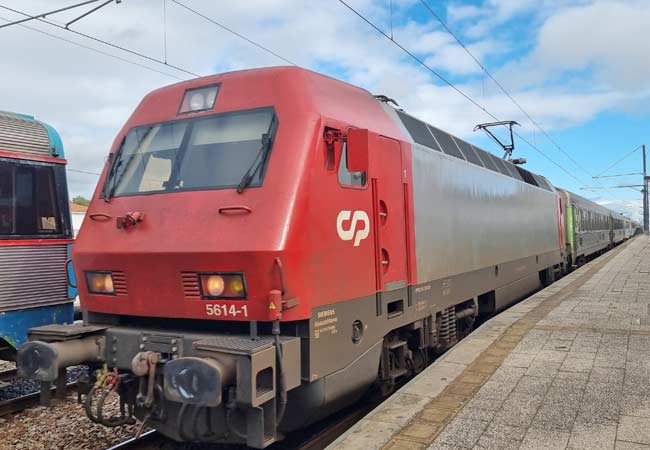
The Intercidade train to Coimbra.
The inconvenience of Porto and Coimbra train stations
The express trains do not stop close (within walking distance) to the city centres in either Porto or Coimbra. For both cities, you will either have to take a very short train ride, which is included in the price, or hire a taxi or Uber.
In Coimbra, the express trains stop at ‘Coimbra B’ station (GPS 40.225, -8.440 - link to Google Maps) which is 2.5 km north of the city centre. From Coimbra B, it is a very short train ride to Coimbra station and the city centre.
Warning: If catching any train from Coimbra, always confirm the departure location. The city centre station, which only handles regional trains, is called ‘Coimbra’, and the station on the main express line is called ‘Coimbra B’. Many visitors miss their express train to Porto or Lisbon by turning up at ‘Coimbra’ station instead of ‘Coimbra B’.
The main train station of Porto is Campanhã (GPS: 41.149, -8.585) which is 2km west of the historic centre. The train station at the centre of Porto is São Bento, and there are regular Urban (U) train services connecting Campanhã and São Bento.
Campanhã train station is also connected to the metro network of Porto, and it may be easier to take the metro, taxi or Uber/Bolt from your accommodation to the train station.
Campanhã and Coimbra B train stations are some of the busiest in Portugal, but they are easy to navigate. There is clear signage, and the departure platform information is displayed on screens 15 minutes before the train leaves. Both stations have ticket offices, cafes and shops.
Campanhã station also has luggage storage suitable for suitcases.
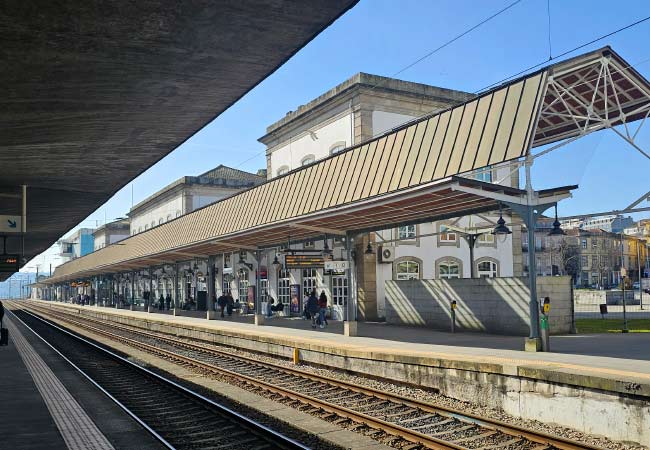
Campanhã train station is modern but nondescript.
Coimbra to Porto by bus
Intercity bus travel in Portugal is safe and reliable, and the buses used are modern and comfortable. There are direct services between Porto and Coimbra, and the journey only takes 1 hour and 20 minutes.
Rede Expressos and FlixBus are the two main operators. FlixBus will have marginally cheaper tickets, but their buses will be fuller.
In Porto, the intercity bus terminal is the Terminal Intermodal de Campanhã, often abbreviated to TIC or simply referred to as Campanhã. It is situated east of the city centre, at GPS 41.151, -8.582 and is connected to the Campanhã train and metro station. Both FlixBus and Rede Expressos depart from and terminate at Campanhã.
This is a newly constructed bus station that is spread over two levels. The buses depart on the ground level, while on the upper floor are the ticket offices, cafes and toilet facilities. The bus departure area can get busy, so always watch the information boards for your departure point.
In Coimbra, Rede Expressos buses stop at the ‘Terminal Rodoviario Coimbra’ (Coimbra bus station), which is 600m from the city centre (GPS: 40.216, -8.437)
FlixBus terminate further out on the Rua do Padrão (GPS: 40.219, -8.439) beneath the bridge that carries the N1 road. From the bus stop, it is a 1.5km walk to Coimbra train station or the Igreja de Santa Cruz. For this ride, you may want to take a taxi or Uber.
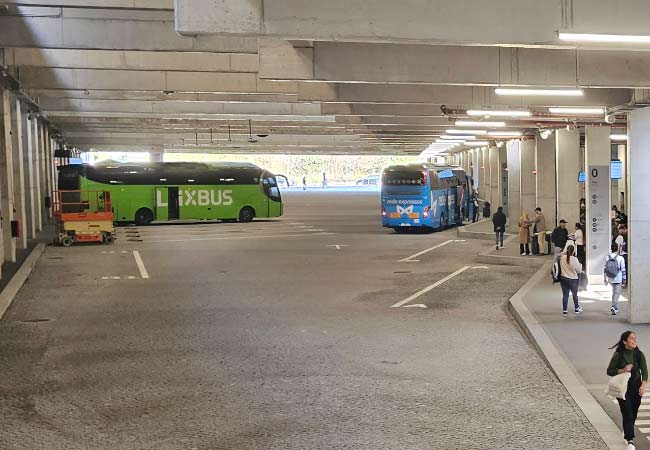
The lower level of the Terminal Intermodal de Campanhã in Porto.
Driving from Porto to Coimbra via the A1
The journey from Porto to Coimbra follows the A1 expressway and is very fast to drive. The A1 is a tolled expressway, with the journey costing €7.10.
The issue with driving to Coimbra is that parking is very difficult to find, and often confusing for foreign drivers. For parking, it is often better to park at the large free car park at ‘Coimbra B’ train station (GPS: 40.225, -8.442) and take an Uber or taxi to the city centre.
Porto Airport to Coimbra
Porto Airport is the nearest international airport to Coimbra.
The best option for travelling from the airport to Coimbra is to take the metro from the airport to Campanhã train station and then catch the express train to Coimbra. The metro from the airport to Porto costs €2.25 (plus €0.60 for an Andante card) and there are departures every 20 minutes, with a journey time of 40 minutes.
If you’d prefer to save money, you could catch an intercity bus instead of the train, and the Campanhã bus station is connected to the Campanhã train station.
Another faster option is to hire a taxi, Uber or Bolt from the airport to Campanhã train station, and this is a good option if travelling with heavy luggage.
Coimbra as a day trip from Porto
It is possible to visit Coimbra as a day trip from Porto, but we recommend a stay of at least one night in the city. There is a lot to see in Coimbra, and the city deserves more than one day of rushed sightseeing.
The other consideration when visiting Coimbra as a day trip by public transport is that tickets must be pre-booked, and there is almost no flexibility on return journeys. When you purchase the train or bus ticket for this route, you have to choose your return train/bus time and are assigned a seat number.
Related articles: The best day trips from Porto
If you've enjoyed our content, we'd like to ask for your support.
The internet landscape has changed, and small independent publishers like us face increasing challenges. Search engines now prioritize advertising over organic content, reducing our traffic, while AI systems increasingly copy our original work without attribution.
To help support us, please consider bookmarking our website for easy access. If you find an article useful, we encourage you to share it with friends or on social media. Equally, if you notice anything outdated or incorrect, please let us know so we can promptly address it.
We're always open to collaborating with brands, bloggers, and SEO/PR agencies who value independent creators. If you'd like to work with us or offer support, please reach out at: [email protected]
Thank you for being part of our community and helping us continue to provide valuable content in an increasingly challenging digital environment.

























